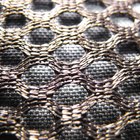
Historians estimate that cotton originated in Egypt several thousand years ago. Today, cotton remains the most widely used fabric in the world. The quality of cotton fabric depends on the fiber as well as the weave and the amount of foreign matter in this natural, plant-based fabric. Stiff, scratchy, poor-quality cotton doesn't hold up to wear, but good-quality cotton feels smooth and durable, often softening with time. Cotton is a low-maintenance fabric, but proper care helps retain the fabric's many positive qualities. Always read the garment care tag because some cottons require dry cleaning while others benefit from being washed by hand.
Step 1
Sort your laundry and divide cotton clothing from other fabrics. Then divide fine cottons such as linen and lingerie from heavy jeans and sweatshirts. Additionally, separate cotton garments into whites, bright colors and dark colors to prevent dark fabric dyes from bleeding onto lighter fabrics.
Step 2
Inspect cotton garments and treat stains using a liquid, gel, stick or aerosol prewash stain remover while the spots are fresh. Washing and drying stained clothing may set in the stains and make them impossible to remove.
Step 3
Soak badly soiled garments in an oxygenated bleach, using warm water to prevent fading the dyes. Fill the washing machine with water and then add one scoop of oxygenated bleach. Add the soiled garment when the powder dissolves and soak the garment for 30 minutes. Read the label on the oxygenated bleach because directions may vary depending on the brand.
Step 4
Turn cotton garments inside out before laundering to preserve the brightness of the colors. Protect delicate garments such as lacy lingerie by placing them in a cotton pillowcase.
Step 5
Refer to the garment care tag and then set the washer on the lowest temperature appropriate for the garment. Hot water may fade the dyes. Use a gentle or delicate cycle for fine fabrics.
Step 6
Place cotton garments in a clothes dryer if indicated on the garment-care tag. Remove the garment as soon as it's dry to reduce wrinkles. If the tag indicates the garment should be air-dried, hang the garment on a rustproof hanger.
Step 7
Iron cotton garments while the fabric is still slightly damp. Avoid excessive drying, which sets in wrinkles and may shrink certain cottons.
Related Articles

How to Clean Cotton-Polyester Blend ...

How to Take Care of 100% Cotton ...

How to Clean a Polyester Coat

How to Wash Cotton Fabric

How to Wash a Tuxedo Shirt

How to Remove Blue Jean Dye Stains from ...

How to Remove Color From White Clothes ...

How to Get Rid of Yellow Age Spots on ...

How to Bleach Mens' Dress Shirts

How to Prevent Cotton Shirts From ...

How to Soften Stiff, Starchy Material

How to Clean a Taffeta Dress

How to Get Wrinkles Out of Nylon ...

How to Wash Dockers

How to Avoid Stretching out Acrylic ...

How to Soften a Canvas Shirt

How to Bleach a Shirt by Hand

How to Clean Viscose Shawls

How to Whiten Jeans

How to Shrink Flannels
References
- Kansas State University Research and Extension: Choose Clothes That Keep You Cool
- Claire Shaeffer's Fabric Sewing Guide; Claire Schaeffer
- University of Tennessee Knoxville College of Engineering: Cotton Fibers
Tips
- Never put cotton clothing away if it isn't completely dry. Cotton is susceptible to mildew and mold.
Writer Bio
M.H. Dyer began her writing career as a staff writer at a community newspaper and is now a full-time commercial writer. She writes about a variety of topics, with a focus on sustainable, pesticide- and herbicide-free gardening. She is an Oregon State University Master Gardener and Master Naturalist and holds a Master of Fine Arts in creative nonfiction writing.
Photo Credits
Photos.com/Photos.com/Getty Images